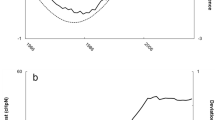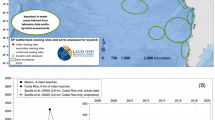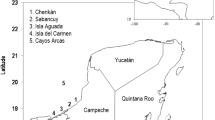Abstract
Assessing the potential impacts of climate change on individual species and populations is essential for the stewardship of ecosystems and biodiversity. Critically endangered leatherback turtles in the eastern Pacific Ocean are excellent candidates for such an assessment because their sensitivity to contemporary climate variability has been substantially studied1,2,3,4. If incidental fisheries mortality is eliminated, this population still faces the challenge of recovery in a rapidly changing climate. Here we combined an Earth system model5, climate model projections assessed by the Intergovernmental Panel on Climate Change6 and a population dynamics model to estimate a 7% per decade decline in the Costa Rica nesting population over the twenty-first century. Whereas changes in ocean conditions had a small effect on the population, the ∼2.5 °C warming of the nesting beach was the primary driver of the decline through reduced hatching success and hatchling emergence rate. Hatchling sex ratio did not substantially change. Adjusting nesting phenology or changing nesting sites may not entirely prevent the decline, but could offset the decline rate. However, if future observations show a long-term decline in hatching success and emergence rate, anthropogenic climate mitigation of nests (for example, shading, irrigation)7,8 may be able to preserve the nesting population.
This is a preview of subscription content, access via your institution
Access options
Subscribe to this journal
Receive 12 print issues and online access
$209.00 per year
only $17.42 per issue
Buy this article
- Purchase on Springer Link
- Instant access to full article PDF
Prices may be subject to local taxes which are calculated during checkout




Similar content being viewed by others
References
Sieg, A. E. Physiological Constraints on the Ecology of Activity-Limited Ectotherms. (Dissertation, Drexel Univ., 2010).
Santidrián Tomillo, P. et al. Climate driven egg and hatchling mortality threaten survival of eastern Pacific leatherback turtles. PLoS One 7, e37602 (2012).
Saba, V. S. et al. The effect of the El Niño Southern Oscillation on the reproductive frequency of eastern Pacific leatherback turtles. J. Appl. Ecol. 44, 395–404 (2007).
Saba, V. S., Spotila, J. R., Chavez, F. P. & Musick, J. A. Bottom-up and climatic forcing on the worldwide population of leatherback turtles. Ecology 89, 1414–1427 (2008).
Rykaczewski, R. R. & Dunne, J. P. Enhanced nutrient supply to the California current ecosystem with global warming and increased stratification in an earth system model. Geophys. Res. Lett. 37, L21606 (2010).
Meehl, G. A. et al. The WCRP CMIP3 multi-model dataset: A new era in climate change research. Bull. Am. Meteorol. Soc. 88, 1383–1394 (2007).
Fuentes, M. M. P. B., Fish, M. R. & Maynard, J. A. Management strategies to mitigate the impacts of climate change on sea turtle’s terrestrial reproductive phase. Mitig. Adapt. Strateg. Glob. Change 17, 51–63 (2012).
Patino-Martinez, J., Marco, A., Quiñones, L. & Hawkes, L. A potential tool to mitigate the impacts of climate change to the Caribbean leatherback sea turtle. Glob. Change. Biol. 18, 401–411 (2012).
Hawkes, L. A., Broderick, A. C., Godfrey, M. H. & Godley, B. J. Climate change and marine turtles. Endangered Species Res. 7, 137–154 (2009).
Chavez, F. P. et al. Biological and chemical response of the equatorial Pacific Ocean to the 1997–98 El Niño. Science 286, 2126–2131 (1999).
Sieg, A. E. et al. Sex ratios of leatherback turtles: Hatchery translocation decreases metabolic heating and female bias. Endangered Species Res. 15, 195–204 (2011).
Santidrián Tomillo, P., Saba, V. S., Piedra, R., Paladino, F. V. & Spotila, J. R. Effects of illegal harvest of eggs on the population decline of leatherback turtles in Marino Las Baulas National Park, Costa Rica. Conserv. Biol. 22, 1216–1224 (2008).
Spotila, J. R., Reina, R. D., Steyermark, A. C., Plotkin, P. T. & Paladino, F. V. Pacific leatherback turtles face extinction. Nature 405, 529–530 (2000).
Sarti Martinez, A. L. Dermochelys coriacea. in IUCN 2011. IUCN Red List of Threatened Species. Version 2011.2 (2000).
Christensen, J. H. et al. in IPCC Climate Change 2007: The Physical Science Basis (eds Solomon, S. et al.) (Cambridge Univ. Press, 2007).
Collins, M. et al. The impact of global warming on the tropical Pacific Ocean and El Niño. Nature Geosci. 3, 391–397 (2010).
Stock, C. A. et al. On the use of IPCC-class models to assess the impact of climate on Living Marine Resources. Prog. Oceanogr. 88, 1–27 (2011).
Hays, G. C., Fossette, S., Katselidis, K. A., Schofield, G. & Gravenor, M. B. Breeding periodicity for male sea turtles, operational sex ratios, and implications in the face of climate change. Conserv. Biol. 24, 1636–1643 (2010).
McMahon, C. R. & Hays, G. C. Thermal niche, large-scale movements and implications of climate change for a critically endangered marine vertebrate. Glob. Change Biol. 12, 1330–1338 (2006).
Eckert, S. A. Distribution of juvenile leatherback sea turtle Dermochelys coriacea sightings. Mar. Ecol. Prog. Ser. 230, 289–293 (2002).
Shillinger, G. L. et al. Persistent leatherback turtle migrations present opportunities for conservation. PLoS Biol. 6, 1408–1416 (2008).
Hoffmann, A. A. & Sgrò, C. M. Climate change and evolutionary adaptation. Nature 470, 479–485 (2011).
Santidrián Tomillo, P. et al. Influence of emergence success on the annual reproductive output of leatherback turtles. Mar. Biol. 156, 2021–2031 (2009).
Ryther, J. H. Photosynthesis and fish production in the sea. Science 166, 72–76 (1969).
Meehl, G. A. et al. in IPCC Climate Change 2007: The Physical Science Basis (eds Solomon, S. et al.) (Cambridge Univ. Press, 2007).
IPCC Special Report on Emissions Scenarios (eds Nakićenović N. & Swart R.) (Cambridge Univ. Press, 2000).
Clune, P. Natural and Human Induced Variations on Beach Dynamics and their Effects on Leatherback Sea Turtle Conservation. Thesis, Indiana-Purdue Univ. (2005).
Wallace, B. P., Kilham, S. S., Paladino, F. V. & Spotila, J. R. Energy budget calculations indicate resource limitation in Eastern Pacific leatherback turtles. Mar. Ecol. Prog. Ser. 318, 263–270 (2006).
Kalnay, E. et al. The NCEP/NCAR 40-year reanalysis project. Bull. Am. Meteorol. Soc. 77, 437–470 (1996).
Adler, R. F. et al. The version 2 Global Precipitation Climatology Project (GPCP) monthly precipitation analysis (1979-Present). J. Hydrometeor. 4, 1147–1167 (2003).
Acknowledgements
Financial support was provided by the Cooperative Institute for Climate Science, Earthwatch Institute, The Betz Chair Endowment of Drexel University and The Leatherback Trust. We thank R. Piedra, C. Padilla and M. Boza for their support to leatherback conservation in Costa Rica. We thank R. Rykaczewski, R. Stouffer andJ. Dunne for reviewing previous versions of this manuscript. We thank J. Dunne and J. John for providing the GFDL-ESM 2.1 simulations used in this study and we thank G. Vecchi and A. Wittenberg for analytical advice. We acknowledge the modelling groups, the Program for Climate Model Diagnosis and Intercomparison and the WCRP’s Working Group on Coupled Modelling for their roles in making available the WCRP CMIP3 multimodel data set. Support of this data set is provided by the Office of Science, US Department of Energy. The NCEP reanalysis air temperature data and GPCP precipitation data was provided by the NOAA/OAR/ESRL PSD, Boulder, Colorado, USA, from their web site (www.esrl.noaa.gov/psd).
Author information
Authors and Affiliations
Contributions
V.S. formulated the hypotheses, experiments, CLIMPOP model and conducted the simulations and analyses. C.S. assisted with the CLIMPOP model formulation, simulations, and analyses. P.S.T. led the nesting-beach field study in Costa Rica and formulated the hatchling recruitment component of the nesting-beach model. J.S. and F.P. also led the field campaign in Costa Rica. V.S. and C.S. wrote the manuscript and all authors discussed the analyses and manuscript text.
Corresponding author
Ethics declarations
Competing interests
The authors declare no competing financial interests.
Supplementary information
Supplementary Information
Supplementary Information (PDF 1984 kb)
Rights and permissions
About this article
Cite this article
Saba, V., Stock, C., Spotila, J. et al. Projected response of an endangered marine turtle population to climate change. Nature Clim Change 2, 814–820 (2012). https://doi.org/10.1038/nclimate1582
Received:
Accepted:
Published:
Issue Date:
DOI: https://doi.org/10.1038/nclimate1582
This article is cited by
-
The good and bad news of long-term monitoring: an increase in abundance but decreased body size suggests reduced potential fitness in nesting sea turtles
Marine Biology (2020)
-
The impacts of extreme El Niño events on sea turtle nesting populations
Climatic Change (2020)
-
Production of male hatchlings at a remote South Pacific green sea turtle rookery: conservation implications in a female-dominated world
Marine Biology (2020)
-
Enhanced, coordinated conservation efforts required to avoid extinction of critically endangered Eastern Pacific leatherback turtles
Scientific Reports (2020)
-
Effects of local climate on loggerhead hatchling production in Brazil: Implications from climate change
Scientific Reports (2019)



